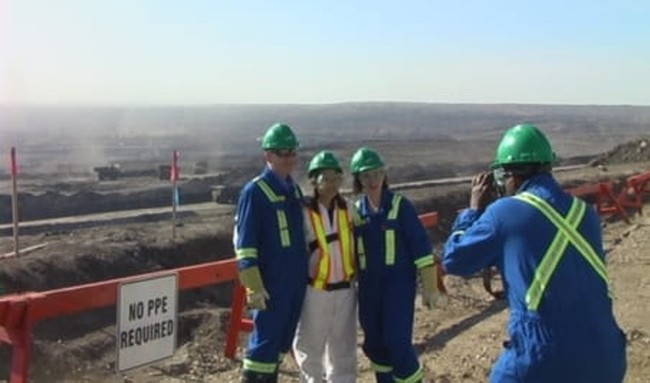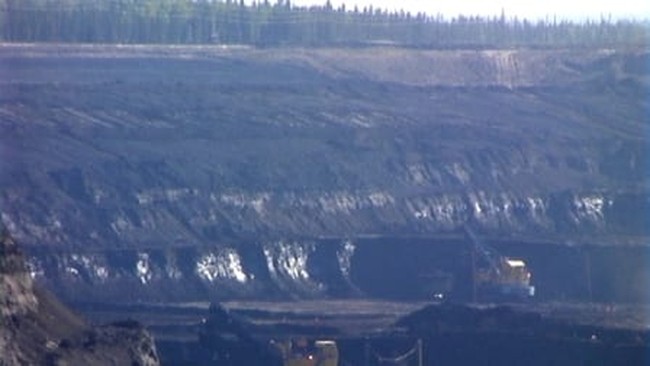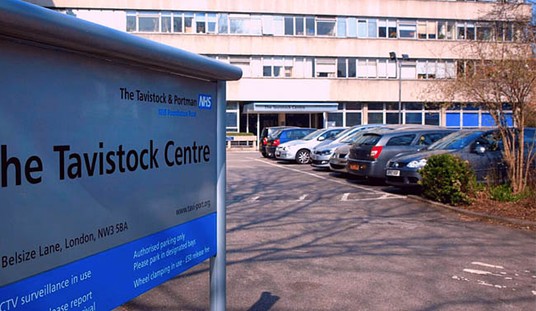Fans of the “all of the above” theory of American energy policy are well aware that we need to be exploring every possible avenue of resources to meet demand in the 21st century. When it comes to oil, most of us think of sweet crude, with gushers coming up out of the ground. Unfortunately, while we have some here in North America, a lot of it sits under countries which don’t exactly have America’s best interests at heart, and it’s not going to last forever. But there are vast deposits of other types in the world, including huge reserves of oil sands in Canada. Unfortunately, there were logistical barriers to accessing these resources in the early days of oil exploration, but modern technological innovations are unlocking the vast potential awaiting us there. And if we’re going to be exploring it, we might as well learn a bit more about it.
I was recently invited to tour a couple of oil sand operations in northern Alberta, Canada, to find out what these advances mean for both Canada and the United States. In a brief series of articles we’re going to take a look at some of the science behind these activities, as well as the effect it’s having on energy supplies, society and the environment. Today we’ll focus on some surface mining operations, moving on to some newer methods later in the week.
What the heck are oil sands?
Oil sands – also called tar sands – are a type of crude oil in the form of bitumen, an extremely viscous, black tar-like substance which is embedded in a mixture of sand, clay and water. The formation being explored in Alberta is part of the Athabasca oil sands deposits. They cover a huge swath of that part of Canada. Roughly 20% of the deposits are close enough to the surface – within a couple hundred feet – to reach by conventional mining techniques, and that’s the portion we’ll cover today. The rest runs much deeper, requiring different technologies which we’ll go into in a later article.
As you might imagine, this stuff can’t just be pumped out of the ground like sweet crude. So in the case of the reserves near the surface, you’ve got to dig it out.
The Mine
The first site we visited was the currently running mine operated by Suncor. And I won’t lie to you… it can be a bit shocking when you first see it. When we pulled up to the edge of the pit my first thought was, “Oh my God. It’s a strip mine.” And this is a massive operation. The picture below is of a few members of our press tour posing in front of the mine. To give you a feel for the full scale, the trucks you see in the distance are capable of carrying up to 400 tons of material and are the size of a small house.

To get to the oil sands, as previously mentioned, they have to cut down through a couple hundred feet of material. This involves removing the topsoil, then layers of earth and then clay (collectively known as “the overburden” in the mining industry) to finally reach the good stuff sitting just above the bedrock. This next shot is the current front of the excavation, showing the various layers which are being removed. The lowest layer – the rich oil sands – has a distinctly shiny appearance as you will see. Again, to get a sense of the scale of the operation, that shovel cutting into the earth has a bucket on it which can pull out nearly 100 tons of material in a single scoop. (I had to take this shot from a great distance on max zoom, but the quality is still fairly good for our purposes.)

After extraction, the bitumen goes through an extensive, highly technical process which we don’t have room to detail here, but the the sands are crushed and processed to remove all of the clay, water and other sediments. The material is then processed into diesel and synthetic crude in preparation for shipment. This is not just experimental technology. The company is already producing 300,000 barrels of fuel per day, with production slated to increase exponentially in the coming decades. You can see detailed videos and papers on the production process at the Suncor site, but I can tell you from first hand experience, it’s an extremely impressive operation.
Production and environmental concerns
As mentioned above, there are obvious environmental questions surrounding such a process. My initial view of the mine was reminiscent of the “bad old days” of mining in the last century when companies searching for copper and other resources would engage in strip mining, laying waste to huge tracts of land and leaving behind total devastation.
There is an additional area of concern in this process given how they have to deal with what are known as “tailings.” This is the residual clay and other material, suspended in water, which must be handled after the bitumen has been extracted. The industry has used “tailing ponds” for this purpose, allowing the material to slowly settle out of the water to the bottom for later reclamation. (And “ponds” is a bit of a euphemism, since they are the size of lakes.) This process can take decades to occur naturally since the particles remain suspended in the fluid for a very long time.
Suncor – along with other companies working in the area – have made impressive strides in dealing with all of these issues. I put the question to Anne Marie Toutant, a mining executive giving us a tour of the mine, asking, “Where does the overburden go? You always mention ‘elsewhere’ but you must have taken out enough to build your own mountain by now.”
The answer was a pleasant surprise. They’re putting it all back where they found it, layering the clay, dirt and topsoil back to their original structure. The company then brings in forestry experts to supervise the planting of ground cover and seedlings native to the area. The process takes years, but they are actually rebuilding the native forests behind them as they go. To date the number of new trees they have planted on reclaimed land is quite literally in the millions.
As for all the water they use, Suncor has managed a fairly amazing feat of containment. They don’t draw off the pristine surface waters of the area, but tap into deep reservoirs of non-potable water. The system is very nearly a closed loop, with pretty much all of the water being recovered from the mining process, recycled and put back into the system. No discharge into the local rivers and streams is allowed and the government – along with citizen groups – monitor water quality on a continuous basis.
As for those tailing ponds, Suncor has pioneered new science which allows them to reclaim all of the water from the clay at a vastly enhanced rate. (We were invited to watch a demonstration of the science first hand, and it’s remarkable.) The clay is then returned to its natural situation as noted above. Instead of dozens of these stagnant ponds, the company is on its way to reducing their need to a single body of water. The old ponds are being reclaimed to their original state, just like the mine itself. Go here for some before and after pictures of their first tailings pond and see what it looks like today. (They also have a live, 24/7 web cam on the site so everyone can keep an eye on them.) What was once a deep reservoir of suspended clay, debris and fouled water is now a vast, sprawling meadow with new trees springing up. During the short tour I had of the former pond, we saw a black bear, a fox, flocks of grouse and raptors moving in to nesting sites the company installed.
VIDEO: Short video tour of the reclaimed tailings pond.
The Bottom Line
The exploration and development of oils sands in Canada is producing tens of thousands of jobs even as we speak. (The industry is currently staffing more than 21,000 high paying jobs just in the Fort McMurray area where I was staying. Suncor employs over 5,000 direct workers, with another 5,000 as contractors or indirect employees.) And they’re not all in Canada. The benefits reach out to us here in the United States. Among other things, the companies purchase some of those giant pieces of earth moving equipment I showed you from Caterpillar, right here in the USA. Also, a lot of the synthetic crude is refined here at home.
VIDEO: The following video was shot on site at the mine where Anne Marie Toutant explains some of the mining process along with how the land reclamation works. The video and audio are a bit rough, but I think it gives a good sense of the sights and sounds at a working mine.
Of course, expansion like that doesn’t come without some growing pains, but we’ll cover more of that in an article to follow, as well as other aspects of the employment opportunities and economic development associated with this work. Next time we will also take a look at some of the cutting edge technology being used by another company to access the deeper reserves of oil sands and how they do it with an even smaller footprint on the land.
DISCLOSURE: Costs for travel and accommodations for this tour were provided by the American Petroleum Institute. No other financial remuneration was offered or accepted. The author was under no obligation to publish any content relating to the tour and neither API nor any of the companies mentioned in this series had any editorial control or input regarding published material beyond fact checking for accuracy.







Join the conversation as a VIP Member